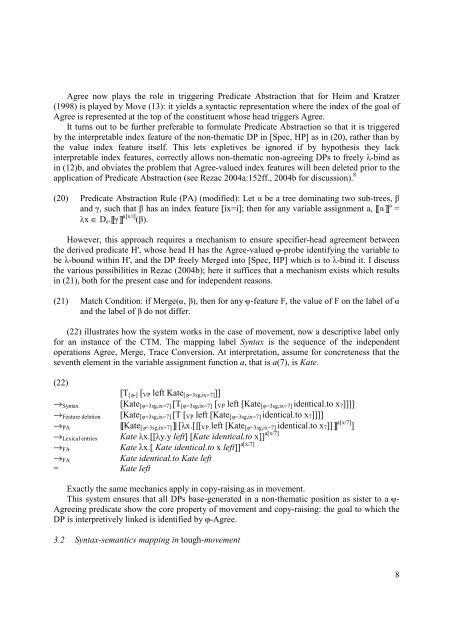1 On tough-movement* Milan Rezac, University ... - Multimania.co.uk
1 On tough-movement* Milan Rezac, University ... - Multimania.co.uk
1 On tough-movement* Milan Rezac, University ... - Multimania.co.uk
Create successful ePaper yourself
Turn your PDF publications into a flip-book with our unique Google optimized e-Paper software.
Agree now plays the role in triggering Predicate Abstraction that for Heim and Kratzer<br />
(1998) is played by Move (13): it yields a syntactic representation where the index of the goal of<br />
Agree is represented at the top of the <strong>co</strong>nstituent whose head triggers Agree.<br />
It turns out to be further preferable to formulate Predicate Abstraction so that it is triggered<br />
by the interpretable index feature of the non-thematic DP in [Spec, HP] as in (20), rather than by<br />
the value index feature itself. This lets expletives be ignored if by hypothesis they lack<br />
interpretable index features, <strong>co</strong>rrectly allows non-thematic non-agreeing DPs to freely λ-bind as<br />
in (12)b, and obviates the problem that Agree-valued index features will been deleted prior to the<br />
application of Predicate Abstraction (see <strong>Rezac</strong> 2004a:152ff., 2004b for discussion). 8<br />
(20) Predicate Abstraction Rule (PA) (modified): Let α be a tree dominating two sub-trees, β<br />
and γ, such that β has an index feature [ix=i]; then for any variable assignment a, [[ α ]] a =<br />
λx ∈ D e .[[ γ ]] a[x/i] (β).<br />
However, this approach requires a mechanism to ensure specifier-head agreement between<br />
the derived predicate H', whose head H has the Agree-valued φ-probe identifying the variable to<br />
be λ-bound within H', and the DP freely Merged into [Spec, HP] which is to λ-bind it. I discuss<br />
the various possibilities in <strong>Rezac</strong> (2004b); here it suffices that a mechanism exists which results<br />
in (21), both for the present case and for independent reasons.<br />
(21) Match Condition: if Merge(α, β), then for any φ-feature F, the value of F on the label of α<br />
and the label of β do not differ.<br />
(22) illustrates how the system works in the case of movement, now a descriptive label only<br />
for an instance of the CTM. The mapping label Syntax is the sequence of the independent<br />
operations Agree, Merge, Trace Conversion. At interpretation, assume for <strong>co</strong>ncreteness that the<br />
seventh element in the variable assignment function a, that is a(7), is Kate.<br />
(22)<br />
[T [φ-] [ VP left Kate [φ=3sg,ix=7]]]<br />
→ Syntax [Kate [φ=3sg,ix=7] [T [φ=3sg,ix=7] [ VP left [Kate [φ=3sg,ix=7] identical.to x 7 ]]]]<br />
→ Feature deletion [Kate [φ=3sg,ix=7] [T [ VP left [Kate [φ=3sg,ix=7] identical.to x 7 ]]]]<br />
→ PA [[ Kate [φ=3sg,ix=7]]] [λx.[ [ VP left [Kate [φ=3sg,ix=7] identical.to x 7 ]] ]] a[x/7] ]<br />
→ Lexical entries Kate λx.[[λy.y left] [Kate identical.to x]] a[x/7]<br />
→ FA<br />
Kate λx.[ Kate identical.to x left]] a[x/7]<br />
→ FA<br />
Kate identical.to Kate left<br />
= Kate left<br />
Exactly the same mechanics apply in <strong>co</strong>py-raising as in movement.<br />
This system ensures that all DPs base-generated in a non-thematic position as sister to a φ-<br />
Agreeing predicate show the <strong>co</strong>re property of movement and <strong>co</strong>py-raising: the goal to which the<br />
DP is interpretively linked is identified by φ-Agree.<br />
3.2 Syntax-semantics mapping in <strong>tough</strong>-movement<br />
8
















